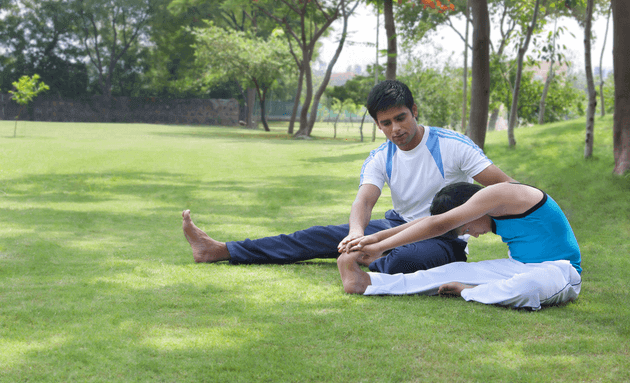How To Get Your Kids To Exercise

From the moment they are born, young children tend to be naturally active in their own tiny ways of kicking their legs in the air as babies, pulling or pushing their arms to grasp objects that are out of their reach, crawling around on all fours. As they grow into toddlers, it is common to see them burning their energy both indoors and outdoors by running everywhere, jumping around on the sofas or bed, or playing hide and seek with loved ones.
When children get to the pre-school and early schooling stages, the more energetic play takes over. Unlike adults, kids enjoy participating in fun and unstructured activities such as riding their bikes, climbing frames, jumping on a trampoline, dancing to music, rolling on the grass, chasing their friends or pets in the park, or even walking or cycling to and from school with a parent. These activities spread throughout the day, achieve the three-hour-daily exercise guideline that is generally recommended for children until the age of five.
However, as school and study periods steadily take priority in the following years until young adulthood, the physical activity gets restricted to school- and sport-training sessions of football, hockey or tennis, and walking or cycling. Additionally, there is the inevitable distraction of the television and screen time on mobiles or other electronic devices. This can be worrying, as sedentary habits can soon result in obese and inactive youngsters. But this can be changed with a slight change in your habits as parents.
Here are 10 ways to get your children to exercise for a healthier future:

- Be a role model: Children naturally absorb both the good and the bad from the adults around them. If you are physically active or take steps towards an active lifestyle with regular activity periods, chances are they will learn from you.
- Start with small steps: Setting unrealistic goals such as pushing your young kid to run 5 kilometres with you can be counter-productive and impractical. Start with smaller and achievable goals that he or she will be proud of, and never force them to do something they don’t feel comfortable about.
- Make exercising social and fun: Focus on the fun element in exercise such as dancing to music, playing musical chairs during a birthday party, a game of cricket, inviting your children’s friends or family for an outing to the park, zoo, etc. If it is safe, allow them to climb trees or other climbing frames.

- Encourage competition: Motivate your kids by race with your kids at the park or, if indoors, challenge them to exercises such as squats, jumping jacks or push-ups. While walking outdoors, use a pedometer to encourage them to set new records in their progress in the number of steps they take. Skipping rope is another great alternative to walking or running outdoors.
- Include kids in the chores around your home: Children love being made to feel important, especially if they are given responsible tasks such as taking a trip to the nearby grocery store, helping with the laundry, sweeping the house/garden, or occasionally, washing your car. If they enjoy being with you in the kitchen, designate tasks like grating vegetables, kneading, or whisking ingredients to bake a cake together. Apart from benefiting from hand-eye coordination and strengthening arm exercises, these tasks also will help promote a sense of self-confidence in young children.

- Make walking and cycling your primary means of transport: Avoid taking the car out every morning and walk with your child to school instead. Park your car at a distance from the store or mall so that you can sneak in some exercise and let them help you to carry the shopping bags back to the car.
- Plan an active holiday: Sometimes, children’s memories of beautiful vacations can turn into future hobbies and interests. Make your annual holiday more exciting by planning on including nature trails, hiking or mountaineering treks, horse-riding, ice-skating, kayaking or camping, or snorkelling and scuba diving, during your break.

- Limit TV and digital screen time: Restrict TV times by using small and fun incentives such as a visit to the local park or play-dates with friends. Although a lot of current study demands the use of technology and apps, limiting their use strictly for homework can be effective, and stops them from being couch-potatoes.
- Enrol in a family exercise class: Martial arts, Zumba or aerobics, badminton, tennis, Yoga, Pilates, swimming, etc, are some of the activities that you can enjoy together as quality family time. Set out some time for any of these activities at least once a week.
- Get toys that promote physical activity: Footballs, roller skates, basketball hoops, bicycles, etc, are great gift ideas that can keep your child physically active. Old-fashioned games such as Twister, tic-tac-toe, hula-hoops or skipping ropes are also effective as energy consumers for young children.

Apart from the above ideas that can coax them into getting physically fit, ensure a healthy diet for the entire family. Enrolling them in various activity classes after school hours for two or three days a week such as gymnastics, martial arts, badminton, etc, will not only help raise their heart rates for an hour during each workout but also teach them important values of teamwork and sportsmanship.






